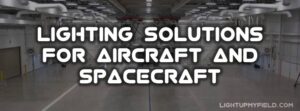
Whether it’s for aircraft or spacecraft, the lighting setup plays a major role in safety, efficiency, and even cost. But did you know the lighting needs for aircraft hangars differ
Reach out now for a free lighting consultation
Lighting might not be the first thing that comes to mind when thinking about aircraft hangars, but get it wrong and you’ll feel the impact right away — in safety, efficiency, and even your budget. Hangars aren’t just big garages; they’re workspaces for detailed inspections, maintenance, and sometimes painting or assembly. That means the lighting system has to do more than make the space bright. It needs to provide consistent, uniform illumination with the right color quality while keeping operating costs manageable.
This guide dives into how to design hangar lighting, what types of fixtures work best, how much it costs to set up and run, and what to keep in mind when replacing or upgrading your system.
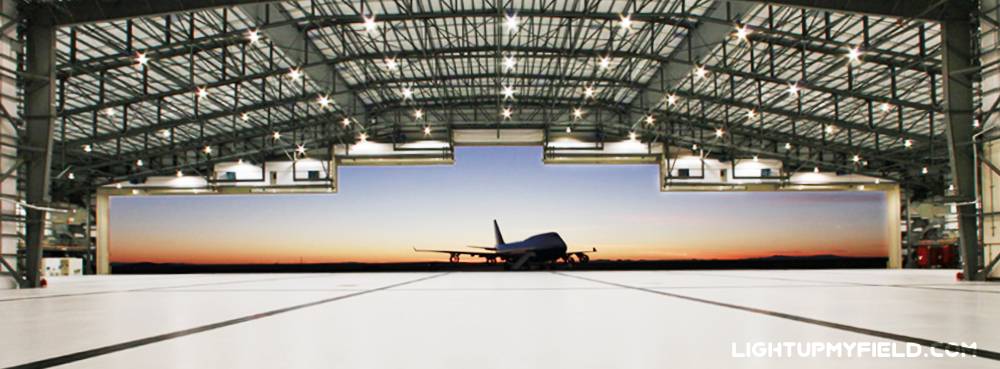
Table of Contents
ToggleDesigning lighting for a hangar is a lot more than just hanging a few bright lamps and hoping for the best. These spaces are massive, and the work inside demands precision. If the lighting isn’t done right, you’ll end up with harsh glare, shadowy spots, or uneven coverage that makes maintenance harder and less safe. When you get it right, though, the entire workspace becomes safer, more efficient, and much easier on the eyes.
Hangar Lighting Key Numbers
| Parameter | Recommended Value / Range |
|---|---|
| General Maintenance Illumination | 300 – 500 lux (≈ 28 – 46 footcandles) |
| Inspection / Detail Work | 750 lux or higher |
| Total Lumens for 50,000 sq ft @ 400 lux | 20,000,000 lumens |
| Example Fixture Output | 40,000 lumens per LED high bay |
| Fixtures Needed (approx.) | ~500 units |
| LED Efficacy | 130 – 160 lumens per watt |
| Color Temperature | 4000K – 5000K |
| CRI (Color Rendering Index) | ≥80 (90+ for inspections) |
| Uniformity Ratio | 0.7 – 0.8 |
| Typical Ceiling Height | 30 – 50 ft |
| Fixture Spacing | 1.0 – 1.5 × mounting height (e.g., 40–60 ft) |
One of the first things you need to figure out is how bright the space should be. For most aircraft hangars, the standard recommendation is 300 to 500 lux (which translates to roughly 28 to 46 footcandles) for general maintenance areas. That’s bright enough to keep the floor and equipment clearly visible without overwhelming the eyes.
For specialized zones like inspection areas, where technicians need to catch tiny cracks or wiring issues, you’ll want 750 lux or even higher. That difference is huge when you think about the level of detail required in these tasks. If the lighting is too low, a small overlooked defect can turn into thousands (or millions) in repair costs later.
Lighting designers often use simulation software and actual lux meter readings to make sure these numbers aren’t just on paper but happen in real life. Otherwise, you risk having to add more fixtures later, which nobody wants — extra cost, extra downtime.
Now, here’s where it gets a little confusing for people: lux and footcandles measure how much light hits a surface, but lumens measure how much light the fixture produces. Both matter.
So, let’s break it down with a real-world example. Say you’re designing lighting for a 50,000-square-foot hangar, and you want 400 lux across the floor. Multiply that out, and you’re looking at 20,000,000 lumens total. Sounds like a big number, right? That’s because hangars are huge.
Now, let’s say you’re using LED high bay fixtures that deliver 40,000 lumens each. Divide it out, and you’d need about 500 fixtures to hit your target. Of course, that’s a rough calculation — beam angle, mounting height, and reflectivity all affect the final count — but it shows why lumen output matters when picking fixtures.
If you choose fixtures with lower lumen output, you’ll need way more of them, which drives up cost, wiring complexity, and maintenance time. So, don’t just look at wattage — lumens per watt (efficacy) is a key spec to check. High-quality LEDs often hit 130-160 lumens per watt, meaning you get more brightness for less energy.
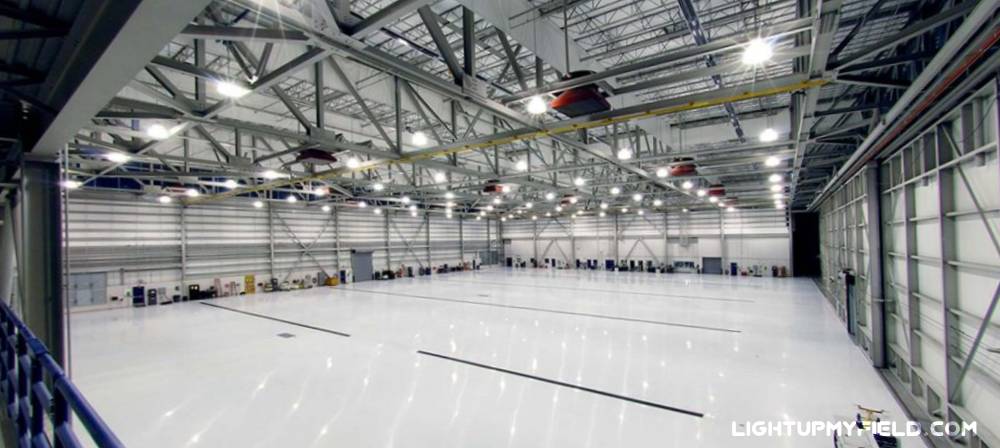
Next up is color quality. It’s not just about brightness — the color temperature and color rendering index (CRI) make a big difference in how comfortable and functional the light is. Most hangars stick to a range of 4000K to 5000K, which is that crisp, neutral white light that feels like daylight. It helps reduce eye strain during long shifts and makes everything look sharp and clear.
CRI tells you how accurately a light source displays colors compared to natural light. For hangar work, you don’t want a CRI lower than 80, and some inspection areas even aim for 90+. Why so high? Because when you’re checking wiring, paint finishes, or warning labels, color accuracy isn’t just nice to have — it can prevent big mistakes.
Ever walked into a space where one area is blindingly bright and another is dim and shadowy? That’s what happens when uniformity is ignored. For hangars, the goal is usually a uniformity ratio of about 0.7 to 0.8, which means the darkest spot should still be at least 70-80% as bright as the average illumination.
Poor uniformity isn’t just annoying; it can cause eye fatigue and missed details, especially when shadows fall under wings or around engines. And given that a wide-body aircraft can cast some serious shadows, you really have to plan fixture placement carefully to balance out those dark spots.

Ceiling height is a huge factor in hangar lighting design. Most hangars have ceilings in the 30 to 50-foot range, and that changes everything. If you spread the fixtures too far apart, you end up with pools of light and dark gaps in between. Pack them too close and you’re wasting energy and money without gaining much benefit.
That’s why high bay fixtures are the go-to choice. They’re designed for tall ceilings and come with beam angles that can focus light downward efficiently. Narrow beam angles are common for hangars because they concentrate light where it matters — on the aircraft and the floor — instead of wasting it on walls or the ceiling.
Lighting design software usually helps determine the ideal spacing, but as a rough guide, fixtures often end up spaced about 1 to 1.5 times the mounting height apart. So if your lights are mounted 40 feet up, spacing might be in the 40 to 60-foot range depending on the beam spread and the overall layout.
Most hangars stick with direct lighting, meaning the light goes straight from the fixture to the work surface. It’s the most efficient way to light such a large space. Indirect lighting — where light bounces off the ceiling — is rare because hangar ceilings are so high and usually not very reflective.
That said, indirect or mixed lighting sometimes shows up in smaller side areas or offices attached to the hangar. Those spaces benefit from softer, more diffused light, which feels more comfortable for desk work and computer use. But when it comes to the main hangar, direct LED high bays dominate the design because they deliver bright, focused light without wasting power.
When it comes to lighting a hangar, you can’t just pick any fixture off the shelf. These spaces are massive, with ceilings that can soar 30, 40, or even 50 feet high, and the lighting has to deal with everything from tiny inspection work to illuminating an entire aircraft wing. Let’s break down the most common options and why they work.
High bay fixtures are pretty much the standard in large hangars. Why? Because they’re specifically built for high ceilings — anything above 20 feet. In fact, many hangars have ceilings closer to 35 or even 50 feet, and that distance means you need a powerful, focused light source to push brightness all the way down to the floor.
LED high bays have become the preferred choice because they tick all the boxes: energy savings of 60–70% compared to metal halide, lifespans of 50,000 to 100,000 hours, and output that often ranges between 20,000 to 60,000 lumens per fixture. That means fewer replacements, less downtime, and a much lower electricity bill.
If you’re wondering about cost, a quality LED high bay can range from $200 to $600 per unit, depending on wattage and features like dimming or smart controls. While that might sound steep, think about how many fewer replacements you’ll need compared to older HID lamps, which often burn out after just 8,000 to 15,000 hours.
Not every hangar is the size of a football field. For smaller spaces or auxiliary rooms with ceilings under 20 feet, low bay lights make more sense. These fixtures have a wider beam angle to spread light evenly across a smaller footprint.
LED low bays generally produce 10,000 to 20,000 lumens and consume less power than high bays, making them ideal for workshops or aircraft storage zones. And like their high bay counterparts, they offer long life and high energy efficiency, which keeps operating costs in check.
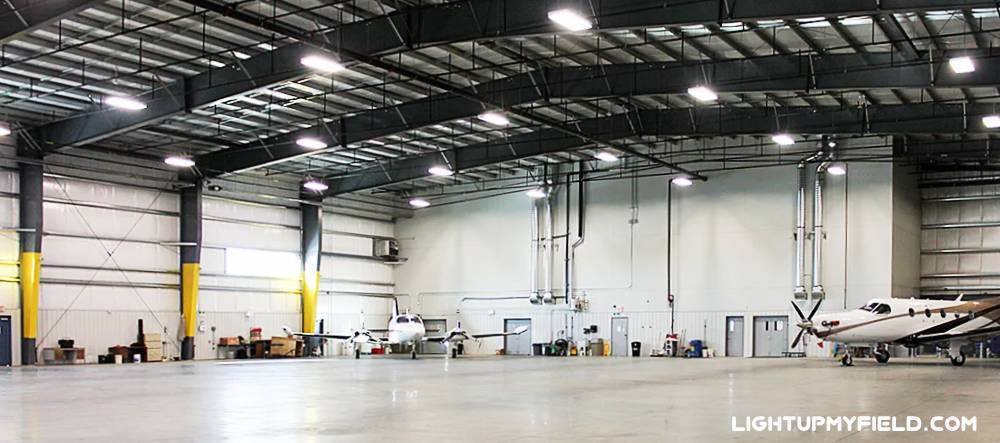
Floodlights come into play when you need wide-area illumination, especially for outdoor aprons, parking areas, or entrances where aircraft are parked overnight. Modern LED floodlights can deliver up to 100,000 lumens and still be surprisingly efficient, consuming far less power than old-school halogen or metal halide options.
They’re also built tough — most LED floodlights come with IP65 or IP66 ratings, meaning they can handle rain, dust, and temperature swings. For large apron spaces, floodlights mounted on poles or hangar walls ensure there are no dark spots where safety could become an issue.
Sometimes, general lighting just doesn’t cut it. In areas like inspection zones, painting booths, or detailing bays, technicians need focused beams to check for surface imperfections, wiring issues, or paint quality. That’s where spotlights shine — literally.
LED spotlights with narrow beam angles (20° or less) provide high-intensity lighting right where it’s needed without flooding the entire space with extra brightness. These lights often run at 2,000 to 5,000 lumens, but the concentrated beam makes them perfect for fine-detail work.
Here’s the truth: no single type of light can handle all the tasks in a hangar. High bays are fantastic for general lighting, but you still need spotlights for inspections and floodlights for outdoor areas. A layered approach ensures every activity, from basic parking to intricate maintenance, gets the right lighting level without wasting energy.
Let’s be real — lighting a hangar isn’t cheap. But the real question is: what’s the total cost over time, not just the upfront price tag? Whether you’re building new or upgrading an existing setup, it helps to break down the costs into different parts so you get the full picture.
LED fixtures have come a long way. A good-quality LED high bay light for a hangar can run you anywhere from $250 to $600 each, depending on the wattage, optics, and whether it has extras like motion sensors or dimming capabilities.
Now, say you’re working with a 50,000-square-foot hangar, and you want a lighting level of around 300 to 400 lux. Depending on how efficient the fixtures are, you’ll likely need 80 to 120 high bay units to cover the space properly. That puts just the fixture cost somewhere between $20,000 and $72,000.
Keep in mind: you don’t always have to go with the most expensive fixture, but don’t go too cheap either. Cheaper units often burn out sooner or don’t deliver consistent brightness, especially in demanding work environments.
Hanging lights in a hangar isn’t like screwing in a bulb at home. With ceiling heights of 30 to 50 feet, you’re going to need scissor lifts, boom lifts, or scaffolding, not to mention skilled electricians. On average, expect installation to cost between $50 and $150 per fixture, depending on your region and how complex the wiring is.
That means, for 100 fixtures, you’re looking at $5,000 to $15,000 just for labor. If you’re also upgrading panels or adding new circuits, the bill can climb even more. Some retrofits might need new conduit or junction boxes, especially if you’re switching from fluorescent or HID systems to LED.
This is where LEDs really start to shine — pun intended. Traditional lighting systems like metal halide or fluorescent can consume anywhere from 400 to 1000 watts per fixture, especially the older 1000W MH units used in large hangars.
LEDs with comparable lumen output usually draw only 150 to 300 watts, sometimes even less. That’s a 50% to 70% drop in energy use, and for a large hangar running lights for 12 to 16 hours a day, those savings add up fast.
To throw some numbers at it:
Let’s say you’re replacing 100 metal halide fixtures using 800W each with 250W LEDs. That’s a savings of 55,000 watts. If you run them for 14 hours a day, 365 days a year, that’s 281,050 kWh saved annually. At $0.12 per kWh, you’re saving over $33,000 per year in electricity alone.
And that’s without even getting into the savings from smart controls like motion sensors or daylight dimming, which can knock another 20–30% off your energy bill.
Another area where LEDs outperform traditional systems is maintenance. Older HID or fluorescent fixtures might need lamp replacements every 10,000 to 20,000 hours — sometimes even sooner if they’re in a dusty or hot environment.
By comparison, most commercial-grade LEDs are rated for 50,000 to 100,000 hours. That could mean 8 to 10 years of use, depending on your schedule, before even thinking about swapping them out. And when your lights are hanging 40 feet up in the air, avoiding regular lift rentals and labor makes a huge difference.
Just think about this: if you had to change bulbs on a 40-foot ceiling every couple of years, the cost of labor, equipment rental, and downtime could easily hit $200 per fixture each time. Over 10 years, those costs can snowball.
If you’re comparing LED systems to older lighting just based on purchase price, LEDs might seem a bit more expensive upfront. But once you roll in energy savings, lower maintenance, and fewer disruptions, LEDs almost always win out long-term.
A full LED retrofit in a large hangar — including fixtures, labor, and smart controls — might land in the $60,000 to $120,000 range, depending on your choices. But that same system could save you $30,000 to $50,000 per year in operating costs. That means a payback period of just 2 to 4 years, and everything after that? Pretty much pure savings.
| Cost Category | Typical Range / Example Calculation |
|---|---|
| Fixture Cost (LED High Bay) | $250 – $600 per fixture |
| Number of Fixtures (50,000 sq ft) | 80 – 120 units |
| Total Fixture Cost | $20,000 – $72,000 |
| Installation Cost | $50 – $150 per fixture |
| Total Installation (100 fixtures) | $5,000 – $15,000 |
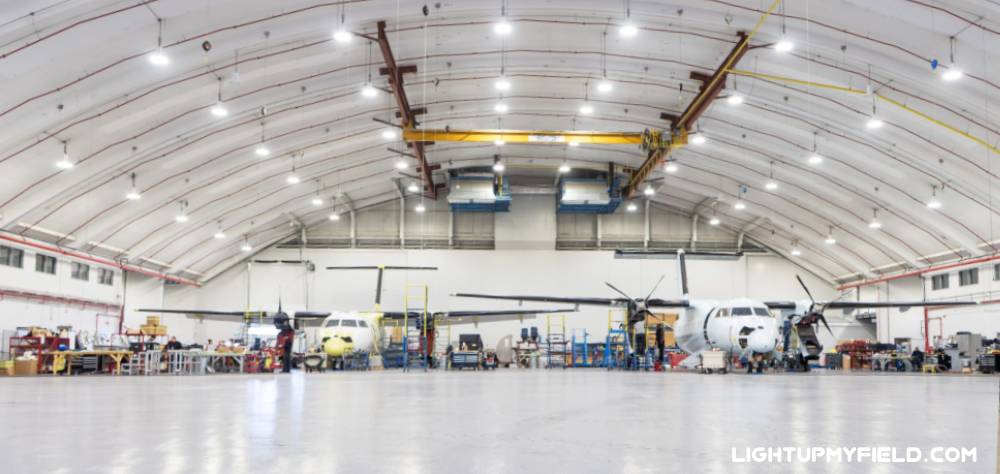
Upgrading a hangar lighting system sounds simple — swap old fixtures for new LEDs and call it a day, right? Not quite. There are a few key things you’ll want to think through first, because skipping these steps can lead to wasted money, unexpected downtime, or even safety issues.
Before you start ordering lights, take stock of what you’ve got. Grab a lux meter and measure the actual lighting levels across different zones. If your hangar is sitting at 150 lux in work areas when standards recommend 300–500 lux, that’s a red flag that you’ll need more than a simple bulb replacement.
Also, look at uniformity. If you’ve got bright spots under fixtures and dark patches near the walls, that’s a design issue, not just a bad lamp. Check the condition of your existing fixtures too. If they’re corroded or the wiring is outdated, retrofitting might not be cost-effective — sometimes a full replacement is the smarter play.
If your plan is to retrofit old metal halide fixtures with LED kits, make sure the kit actually works with the existing housings and wiring. Not all retrofit kits are created equal, and some can’t handle the heat or electrical load differences.
A lot of times, trying to reuse old ballasts is more trouble than it’s worth. If the fixture is 20 years old, replacing it entirely usually makes sense. You’ll get better light output, higher efficiency, and a clean warranty, which retrofit kits often don’t cover as well.
This is the perfect time to add smart controls. Motion sensors, dimming options, and daylight harvesting systems can boost your energy savings by another 20–30% on top of what LEDs already offer.
Hangar doors often stay open during the day, so why waste power blasting full brightness when natural sunlight can pick up the slack? Automated controls take care of this without anyone flipping a switch.
Here’s the thing: replacing lights in a hangar isn’t a two-hour job. With 30 to 50-foot ceilings, you’re going to need lifts, safety gear, and trained electricians. Each fixture can take 30–60 minutes to swap out, which adds up fast when you’re dealing with 100+ lights.
Schedule upgrades during maintenance downtimes or low-traffic periods to keep operations running smoothly. A poorly timed project could ground aircraft or delay schedules — and nobody wants that.
Hangar lighting might not seem like the most exciting part of aviation infrastructure, but it touches everything — from worker safety and productivity to your bottom line. A well-designed system with efficient LEDs and smart controls can slash energy costs by 50-70%, cut maintenance to almost nothing, and keep your hangar bright and comfortable for years to come. Whether you’re designing from scratch or upgrading an older setup, taking the time to plan pays back in a big way.

Whether it’s for aircraft or spacecraft, the lighting setup plays a major role in safety, efficiency, and even cost. But did you know the lighting needs for aircraft hangars differ
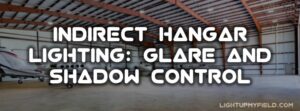
When it comes to lighting up aircraft hangars, the struggle between bright enough and too harsh is real. Those big shiny planes reflect a lot of light, and the last
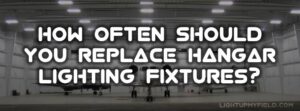
Over time, the fixtures up there start to wear down, lose brightness, or just plain stop working. So, how often should you really replace those hangar lighting fixtures? It’s a

Aircraft hangar is huge, and the lighting needs are very different from what you’d find in a warehouse or a workshop. Mechanics need clear, consistent light to check every detail,

Hangars are massive spaces, and the wrong lighting setup can make work harder and even less safe. Choosing between high bay and low bay lights is one of the first
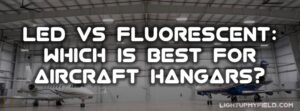
When it comes to lighting up aircraft hangars, the choice between LED and fluorescent fixtures pops up a lot. Both have been around for a while, but which one really
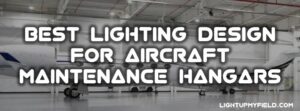
Designing the right lighting for an aircraft hangar isn’t just about putting up a few bright fixtures and calling it a day. These are huge spaces with unique challenges—massive ceilings,
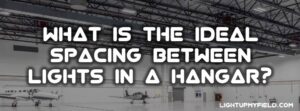
Lighting a hangar sounds simple at first glance—just install bright fixtures and you’re good to go, right? But once you start digging into the details, you realize spacing between lights
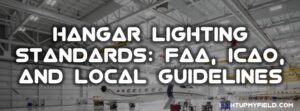
Lighting in aircraft hangars might seem like just another part of the design process, but it plays a huge role in how well everything works inside. From maintenance inspections to